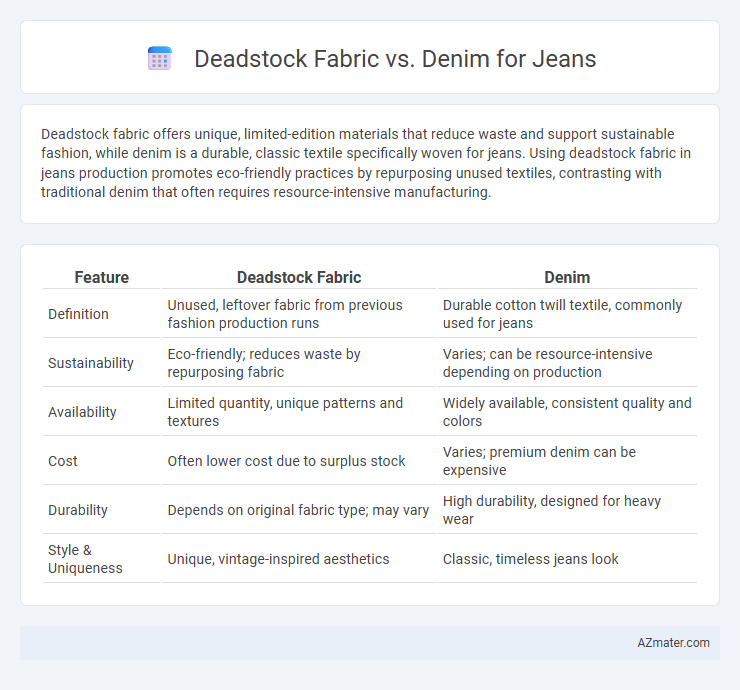Deadstock fabric offers unique, limited-edition materials that reduce waste and support sustainable fashion, while denim is a durable, classic textile specifically woven for jeans. Using deadstock fabric in jeans production promotes eco-friendly practices by repurposing unused textiles, contrasting with traditional denim that often requires resource-intensive manufacturing.
Table of Comparison
| Feature | Deadstock Fabric | Denim |
|---|---|---|
| Definition | Unused, leftover fabric from previous fashion production runs | Durable cotton twill textile, commonly used for jeans |
| Sustainability | Eco-friendly; reduces waste by repurposing fabric | Varies; can be resource-intensive depending on production |
| Availability | Limited quantity, unique patterns and textures | Widely available, consistent quality and colors |
| Cost | Often lower cost due to surplus stock | Varies; premium denim can be expensive |
| Durability | Depends on original fabric type; may vary | High durability, designed for heavy wear |
| Style & Uniqueness | Unique, vintage-inspired aesthetics | Classic, timeless jeans look |
Introduction to Deadstock Fabric and Denim
Deadstock fabric refers to unused, surplus textile inventory often sourced from past production runs, making it a sustainable and cost-effective choice for fashion makers. Denim, a durable cotton twill textile, is the classic material for jeans, prized for its strength and timeless style. Comparing deadstock fabric to denim highlights opportunities to reduce waste while maintaining the iconic appeal and durability essential for quality jeans.
What is Deadstock Fabric?
Deadstock fabric refers to unused, leftover textile materials from previous production runs or collections, often vintage or limited-edition, that remaining unsold or unused by manufacturers. Unlike denim, which is specifically woven cotton twill fabric used primarily for jeans construction, deadstock fabrics can include a variety of materials and patterns not limited to denim. Utilizing deadstock fabric for jeans promotes sustainability by repurposing high-quality, rare materials that would otherwise go to waste, offering unique and eco-friendly alternatives to conventional denim.
Understanding Traditional Denim
Traditional denim is a sturdy cotton twill fabric known for its distinctive diagonal weave and indigo-dyed warp threads, which create the classic blue color of jeans. Deadstock fabric refers to unused, surplus textile inventory often produced in limited quantities, offering unique patterns and high-quality materials that can include vintage denim styles. Understanding traditional denim's durability and cultural significance helps appreciate how deadstock fabric can provide sustainable and distinctive alternatives in jean production.
Sustainability: Deadstock Fabric vs Denim
Deadstock fabric significantly reduces environmental impact by reusing surplus textiles that would otherwise contribute to landfill waste, promoting circular fashion practices. Traditional denim production requires substantial water and chemical inputs, leading to higher ecological footprints compared to repurposed deadstock materials. Choosing deadstock fabric for jeans supports sustainability by minimizing resource consumption and waste generation inherent in conventional denim manufacturing.
Quality and Durability Comparison
Deadstock fabric often provides superior quality for jeans due to its limited production and vintage materials, resulting in unique textures and finishes that are rare in mass-produced denim. Denim, especially selvage and high-grade varieties, is renowned for its durability, with tightly woven cotton fibers that withstand wear and tear over time. When comparing both, deadstock fabric can offer exclusive aesthetics and comparable durability, but traditional denim remains the benchmark for long-lasting, robust jeans.
Cost Implications: Deadstock vs Traditional Denim
Deadstock fabric often offers significant cost savings compared to traditional denim, as it utilizes surplus materials leftover from previous production runs, reducing raw material expenses. Traditional denim requires fresh cotton sourcing and extensive manufacturing processes, which increase overall costs for producers and consumers alike. Utilizing deadstock fabric can lower production costs for jeans, making sustainable fashion more accessible without compromising quality.
Creative Potential and Design Flexibility
Deadstock fabric offers unique creative potential for jeans designers by providing rare, limited-quantity textiles that add distinct texture and patterns unavailable in standard denim. Its diverse origins allow for innovative experimentation with color, weave, and material blend, enhancing design flexibility beyond the traditional indigo-dyed denim. Unlike conventional denim, deadstock fabric enables sustainable, one-of-a-kind jeans that stand out in the fashion market through custom, artisanal aesthetics.
Availability and Sourcing Challenges
Deadstock fabric offers limited availability due to its reliance on surplus or discontinued textile stocks, making sourcing unpredictable and sporadic for jean production. Denim, widely produced and continuously manufactured, provides consistent access through established supply chains and multiple global mills. The scarcity of deadstock fabric often results in higher costs and smaller batch sizes, while denim sourcing benefits from economies of scale and steady market demand.
Environmental Impact Analysis
Deadstock fabric significantly reduces environmental impact by repurposing surplus materials that would otherwise contribute to landfill waste, lowering resource consumption and carbon emissions throughout production. Denim manufacturing typically involves intensive water usage, chemical treatments, and energy consumption, resulting in a higher ecological footprint compared to using deadstock fabric. Choosing deadstock fabric for jeans aligns with sustainable fashion practices by minimizing waste and conserving natural resources.
Which Fabric is Best for Your Jeans?
Deadstock fabric offers unique, limited-edition materials that can provide exclusive textures and patterns for jeans, making each pair distinct and environmentally friendly by repurposing unused textiles. Denim, traditionally crafted from durable cotton twill, remains the industry standard known for its strength, comfort, and classic appeal in jeans production. Choosing the best fabric depends on your preference for sustainability and uniqueness with deadstock or proven durability and timeless style with denim.

Infographic: Deadstock Fabric vs Denim for Jeans
 azmater.com
azmater.com